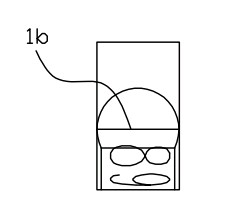Metal line marker for fishes
A metal wire and fish technology, applied in the field of artificial markers, can solve the problems of continuous regeneration of fish fins, achieve stable and clear identification numbers, reduce resistance, and be suitable for mass production
- Summary
- Abstract
- Description
- Claims
- Application Information
AI Technical Summary
Problems solved by technology
Method used
Image
Examples
Embodiment
[0014] Example: refer to Figure 1 to Figure 3 , a fish metal wire marker, comprising a wire marker body 1, wherein: the front end of the wire marker body 1 has a wedge-shaped head 1b; the tail end of the wire marker body 1 has a split tail end 1c, and the split tail end 1c A cylindrical impact hole 1d is formed on the central axis of the base; part of the side of the line mark body 1 is a cylindrical surface, and the other part is a non-cylindrical marking surface 1a. The wedge-shaped head 1b of the wire mark body 1 can reduce resistance during the process of penetrating into the marking target. Since the line marker body 1 is made of metal and has elasticity, the split tail end 1c is also elastic. During the injection process, the split tail end 1c is at a position where they are close together. After entering the working depth, the split tail end 1c It is more open than the injection process, so it can get stuck in the marking target. The cylindrical impact hole 1d is for...
PUM
 Login to View More
Login to View More Abstract
Description
Claims
Application Information
 Login to View More
Login to View More - R&D Engineer
- R&D Manager
- IP Professional
- Industry Leading Data Capabilities
- Powerful AI technology
- Patent DNA Extraction
Browse by: Latest US Patents, China's latest patents, Technical Efficacy Thesaurus, Application Domain, Technology Topic, Popular Technical Reports.
© 2024 PatSnap. All rights reserved.Legal|Privacy policy|Modern Slavery Act Transparency Statement|Sitemap|About US| Contact US: help@patsnap.com










